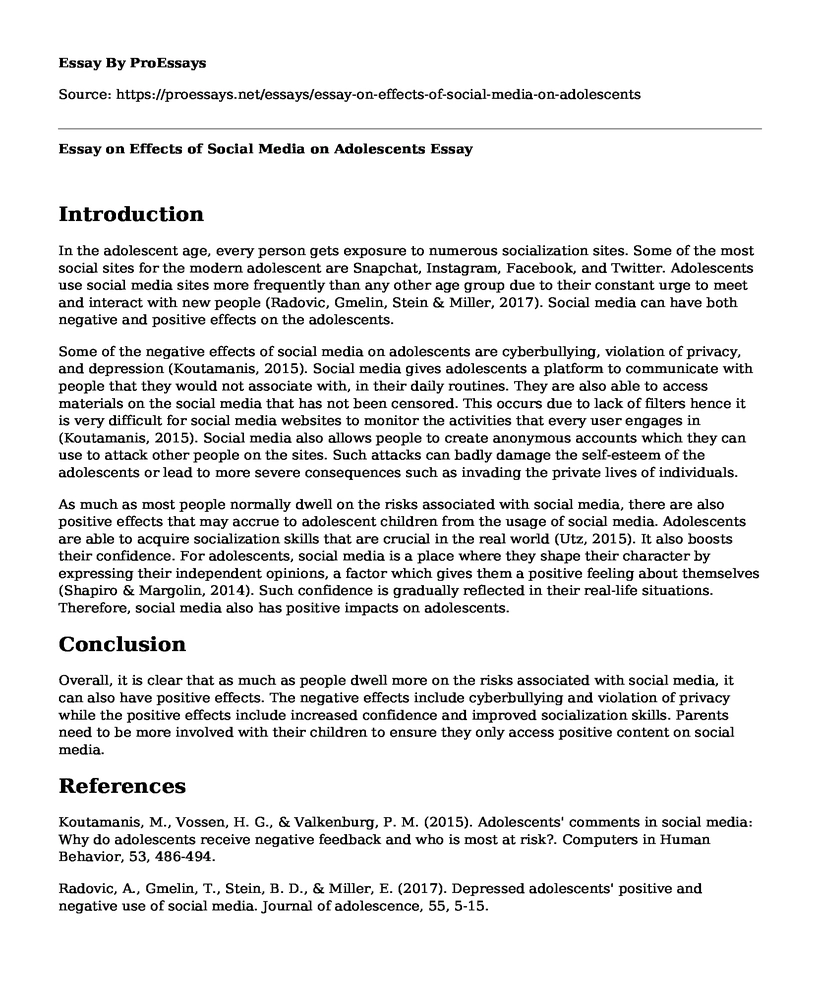Introduction
In the adolescent age, every person gets exposure to numerous socialization sites. Some of the most social sites for the modern adolescent are Snapchat, Instagram, Facebook, and Twitter. Adolescents use social media sites more frequently than any other age group due to their constant urge to meet and interact with new people (Radovic, Gmelin, Stein & Miller, 2017). Social media can have both negative and positive effects on the adolescents.
Some of the negative effects of social media on adolescents are cyberbullying, violation of privacy, and depression (Koutamanis, 2015). Social media gives adolescents a platform to communicate with people that they would not associate with, in their daily routines. They are also able to access materials on the social media that has not been censored. This occurs due to lack of filters hence it is very difficult for social media websites to monitor the activities that every user engages in (Koutamanis, 2015). Social media also allows people to create anonymous accounts which they can use to attack other people on the sites. Such attacks can badly damage the self-esteem of the adolescents or lead to more severe consequences such as invading the private lives of individuals.
As much as most people normally dwell on the risks associated with social media, there are also positive effects that may accrue to adolescent children from the usage of social media. Adolescents are able to acquire socialization skills that are crucial in the real world (Utz, 2015). It also boosts their confidence. For adolescents, social media is a place where they shape their character by expressing their independent opinions, a factor which gives them a positive feeling about themselves (Shapiro & Margolin, 2014). Such confidence is gradually reflected in their real-life situations. Therefore, social media also has positive impacts on adolescents.
Conclusion
Overall, it is clear that as much as people dwell more on the risks associated with social media, it can also have positive effects. The negative effects include cyberbullying and violation of privacy while the positive effects include increased confidence and improved socialization skills. Parents need to be more involved with their children to ensure they only access positive content on social media.
References
Koutamanis, M., Vossen, H. G., & Valkenburg, P. M. (2015). Adolescents' comments in social media: Why do adolescents receive negative feedback and who is most at risk?. Computers in Human Behavior, 53, 486-494.
Radovic, A., Gmelin, T., Stein, B. D., & Miller, E. (2017). Depressed adolescents' positive and negative use of social media. Journal of adolescence, 55, 5-15.
Shapiro, L. A. S., & Margolin, G. (2014). Growing up wired: Social networking sites and adolescent psychosocial development. Clinical child and family psychology review, 17(1), 1-18.
Utz, S. (2015). The function of self-disclosure on social network sites: Not only intimate, but also positive and entertaining self-disclosures increase the feeling of connection. Computers in Human Behavior, 45, 1-10.
Cite this page
Essay on Effects of Social Media on Adolescents. (2022, May 30). Retrieved from https://proessays.net/essays/essay-on-effects-of-social-media-on-adolescents
If you are the original author of this essay and no longer wish to have it published on the ProEssays website, please click below to request its removal:
- Essay on Documentary Analysis: 13th (2016), The Mask You Live In (2015)
- The Fashion Police: Gender and the Rules of Beauty
- Film Analysis Essay on Fireproof
- Essay Sample on Richard Hamilton`s Artworks
- Aging: Physical, Biological & Mental Changes in Middle Age - Essay Sample
- Gender Identity: A Natural Part of Adult Personality - Essay Sample
- Essay Example on the Power of Speech: Communicating to Mass Audiences Throughout History







